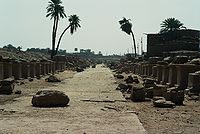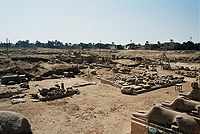
Precinct of Mut
Encyclopedia





Luxor
Luxor is a city in Upper Egypt and the capital of Luxor Governorate. The population numbers 487,896 , with an area of approximately . As the site of the Ancient Egyptian city of Thebes, Luxor has frequently been characterized as the "world's greatest open air museum", as the ruins of the temple...
, Egypt
Egypt
Egypt , officially the Arab Republic of Egypt, Arabic: , is a country mainly in North Africa, with the Sinai Peninsula forming a land bridge in Southwest Asia. Egypt is thus a transcontinental country, and a major power in Africa, the Mediterranean Basin, the Middle East and the Muslim world...
, is one of the four main temple
Egyptian temple
Egyptian temples were built for the official worship of the gods and commemoration of pharaohs in Ancient Egypt and in regions under Egyptian control. These temples were seen as houses for the gods or kings to whom they were dedicated...
enclosures that make up the immense Karnak Temple Complex
Karnak
The Karnak Temple Complex—usually called Karnak—comprises a vast mix of decayed temples, chapels, pylons, and other buildings, notably the Great Temple of Amun and a massive structure begun by Pharaoh Ramses II . Sacred Lake is part of the site as well. It is located near Luxor, some...
and occupies some 150,000 m². It is dedicated to the Egyptian
Ancient Egypt
Ancient Egypt was an ancient civilization of Northeastern Africa, concentrated along the lower reaches of the Nile River in what is now the modern country of Egypt. Egyptian civilization coalesced around 3150 BC with the political unification of Upper and Lower Egypt under the first pharaoh...
goddess Mut
Mut
Mut, which meant mother in the ancient Egyptian language, was an ancient Egyptian mother goddess with multiple aspects that changed over the thousands of years of the culture. Alternative spellings are Maut and Mout. She was considered a primal deity, associated with the waters from which...
, the mother goddess
Mother goddess
Mother goddess is a term used to refer to a goddess who represents motherhood, fertility, creation or embodies the bounty of the Earth. When equated with the Earth or the natural world such goddesses are sometimes referred to as Mother Earth or as the Earth Mother.Many different goddesses have...
. The area in which the precinct is located, originally was known as Isheru (or Asher). Isheru was the name of the spring-fed, crescent shaped lake on the site of this portion of the temple complex. Currently the area is not open to the public or to tourists.
Brief history
It has been used, added to, or enhanced from the 18th DynastyEighteenth dynasty of Egypt
The eighteenth dynasty of ancient Egypt is perhaps the best known of all the dynasties of ancient Egypt...
to the Graeco-Roman Period of rule in Egypt. By the 1st century its use steadily had declined and when worship of Mut stopped, so did the function of the complex. After that, time has not been kind to it. Today, the site is so levelled that practically nothing over one metre high is still standing. Hundreds of statues are scattered all over the central part of the site.
The Goddess Mut
The goddess Mut was the wife of Amun, Egypt's imperial god, and the mother of the moon-god, Khonsu. In her human guise she was the heavenly regent of the kingship. In the form of lioness-headed SakhmetFeatures
Its main features are the crescentCrescent
In art and symbolism, a crescent is generally the shape produced when a circular disk has a segment of another circle removed from its edge, so that what remains is a shape enclosed by two circular arcs of different diameters which intersect at two points .In astronomy, a crescent...
-shaped lake, the later temple of Ramesses III
Ramesses III
Usimare Ramesses III was the second Pharaoh of the Twentieth Dynasty and is considered to be the last great New Kingdom king to wield any substantial authority over Egypt. He was the son of Setnakhte and Queen Tiy-Merenese. Ramesses III is believed to have reigned from March 1186 to April 1155 BCE...
, the temple of Mut, and the temple of Khonsupakhred. In addition there are a number of smaller buildings and shrines, as well as the temple of Nectanebo II
Nectanebo II
Nectanebo II was the third and last pharaoh of the Thirtieth dynasty, as well as the last native ruler of Ancient Egypt. Under Nectanebo II Egypt prospered...
, the bark station of Hatshepsut
Hatshepsut
Hatshepsut also Hatchepsut; meaning Foremost of Noble Ladies;1508–1458 BC) was the fifth pharaoh of the eighteenth dynasty of Ancient Egypt...
and Thutmose III
Thutmose III
Thutmose III was the sixth Pharaoh of the Eighteenth Dynasty. During the first twenty-two years of Thutmose's reign he was co-regent with his stepmother, Hatshepsut, who was named the pharaoh...
, and the Sanctuary of Amun-Kamutef
Amun
Amun, reconstructed Egyptian Yamānu , was a god in Egyptian mythology who in the form of Amun-Ra became the focus of the most complex system of theology in Ancient Egypt...
, which is located just outside the enclosing wall. Kamutef, the Bull of His Mother, would have been the solar god offspring of Hathor
Hathor
Hathor , is an Ancient Egyptian goddess who personified the principles of love, beauty, music, motherhood and joy. She was one of the most important and popular deities throughout the history of Ancient Egypt...
, another aspect of Mut. In later mythology he becomes the counterpart of Mut, identified as a husband.
From the main entrance an approximately 400m long avenue of ram-headed sphinxes leads north, directly to the tenth pylon
Pylon (architecture)
Pylon is the Greek term for a monumental gateway of an Egyptian temple It consists of two tapering towers, each surmounted by a cornice, joined by a less elevated section which enclosed the entrance between them. The entrance was generally about half the height of the towers...
of the Precinct of Amun-Re. This avenue is under restoration. Another avenue of sphinxes, also starting from the entrance, leads 250m west to catch up and flow into the 3km long avenue of sphinxes that connects the Gateway of Ptolemy III Euergetes I of the Precinct of Amen-Re with Luxor Temple
Luxor Temple
Luxor Temple is a large Ancient Egyptian temple complex located on the east bank of the River Nile in the city today known as Luxor and was founded in 1400 BCE.,...
.
Excavations
The area was visited and surveyed by Napoleon's expedition in 1799-1801, and then by The Royal Prussian Expedition of 1842-1845, which was led by Karl Richard LepsiusKarl Richard Lepsius
Karl Richard Lepsius was a pioneering Prussian Egyptologist and linguist and pioneer of modern archaeology.-Background:...
. Recording continued under Auguste Mariette
Auguste Mariette
François Auguste Ferdinand Mariette was a French scholar, archaeologist and Egyptologist, the designer of the rebuilt Egyptian Museum under Maximilian of Austria orders when the later had gained control of the artifacts collected to that point.-Early career:Born at Boulogne-sur-Mer, Mariette...
and Gaston Maspero
Gaston Maspero
Gaston Camille Charles Maspero was a French Egyptologist.-Life:Gaston Maspero was born in Paris to parents of Lombard origin. While at school he showed a special taste for history, and by the age of fourteen he was already interested in hieroglyphic writing...
, but it was Margaret Benson
Margaret Benson
Margaret Benson was an English author and amateur Egyptologist and one of the six children of Edward White Benson, an Anglican clergyman , and his wife Mary Sidgwick Benson, the sister of philosopher Henry Sidgwick...
and Janet Gourlay
Janet Gourlay
Janet A. Gourlay was a Scottish Egyptologist, born in Glasgow.She briefly studied at University College, London, with William Matthew Flinders Petrie and joined Margaret Benson in 1896 in her second season of excavation at the Mut Complex in Karnak, Thebes, in Egypt. She became Margaret's...
who undertook the first major excavations in 1895 through 1897. The area was not excavated again until the 1920s by Maurice Pillet. Since 1976, when the Egyptian government granted the Brooklyn Museum
Brooklyn Museum
The Brooklyn Museum is an encyclopedia art museum located in the New York City borough of Brooklyn. At 560,000 square feet, the museum holds New York City's second largest art collection with roughly 1.5 million works....
exploration rights to the entire site, it has been in a state of ongoing excavation and restoration, and presumably it will be a while before that changes. The Detroit Institute of Arts
Detroit Institute of Arts
The Detroit Institute of Arts is a renowned art museum in the city of Detroit. In 2003, the DIA ranked as the second largest municipally owned museum in the United States, with an art collection valued at more than one billion dollars...
also is associated with this excavation, together with a Johns Hopkins University
Johns Hopkins University
The Johns Hopkins University, commonly referred to as Johns Hopkins, JHU, or simply Hopkins, is a private research university based in Baltimore, Maryland, United States...
team, under Betsy Bryan
Betsy Bryan
Betsy Morrell Bryan is an American Egyptologist who is leading a team that is excavating the Precinct of Mut complex in Karnak, at Luxor in Upper Egypt....
who has uncovered many details about a building projects of the pharaoh, Hatsheput that included adding the porch for use in the Festival of Drunkenness that celebrated a change of the goddess Sekhmet
Sekhmet
In Egyptian mythology, Sekhmet , was originally the warrior goddess as well as goddess of healing for Upper Egypt. She is depicted as a lioness, the fiercest hunter known to the Egyptians. It was said that her breath created the desert...
(an aspect of Mut) from a fierce warrior lioness needed during a long period of war, to a more peaceful figure.

